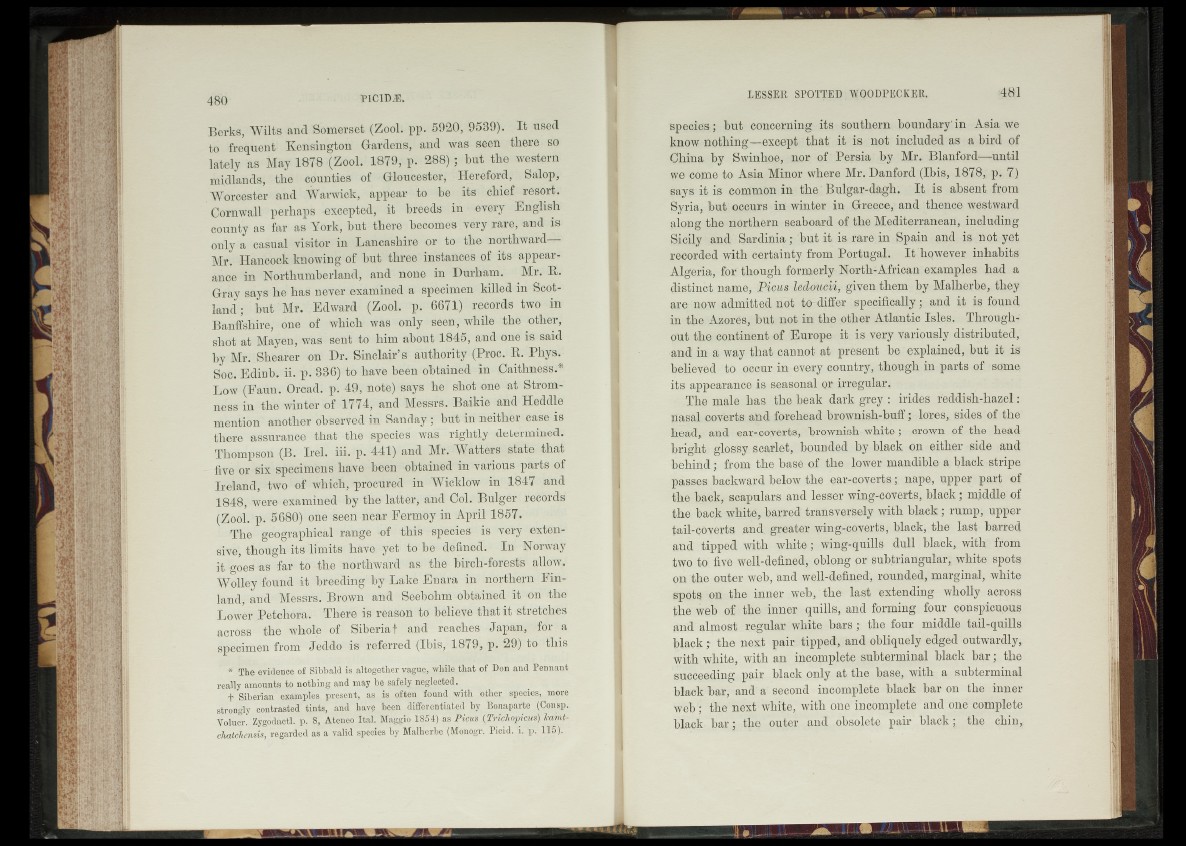
Berks, Wilts and Somerset (Zool. pp. 5920, 9589). It used
to frequent Kensington Gardens, and was seen there so
lately as May 1878 (Zool. 1879, p. 288); but the western
midlands, the counties of Gloucester, Hereford, Salop,
Worcester and Warwick, appear to he its chief resort.
Cornwall perhaps excepted, it breeds in every English
county as far as York, hut there becomes very rare, and is
only a casual visitor in Lancashire or to the northward
Mr. Hancock knowing of hut three instances of its appearance
in Northumberland, and none in Durham. Mr. R.
Gray says he has never examined a specimen killed in Scotland
; hut Mr. Edward (Zool. p. 6671) records two in
Banffshire, one of which was only seen, while the other,
shot at Mayen, was sent to him about 1845, and one is said
by Mr. Shearer on Dr. Sinclair’s authority (Proc. R. Phys.
Soc. Edinh. ii. p. 836) to have been obtained in Caithness.*
Low (Faun. Oread, p. 49, note) says he shot one at Strom-
ness in the winter of 1774, and Messrs. Baikie and Heddle
mention another observed in Sand ay; hut in neither case is
there assurance that the species was rightly determined.
Thompson (B. Irel. iii. p. 441) and Mr. Watters state that
five or six specimens have been obtained in various parts of
Ireland, two of which, procured in Wicklow in 1847 and
1848, were examined by the latter, and Col. Bulger records
(Zool. p. 5680) one seen near Eermoy in April 1857.
The geographical range of this species is very extensive,
though its limits have yet to he defined. In Norway
it goes as far to the northward as the birch-forests allow.
Wolley found it breeding by Lake Enara in northern Finland,
and Messrs. Brown and Seebohm obtained it on the
Lower Petchora. There is reason to believe that it stretches
across the whole of Siberia f and reaches Japan, for a
specimen from Jeddo is referred (Ibis, 1879, p. 29) to this
* The evidence of Sibbald is altogether vague, while that of Don and Pennant
really amounts to nothing and may be safely neglected.
+ Siberian examples present, as is often found with other species, more
strongly contrasted tints, and have been differentiated by Bonaparte (Consp.
Volucr. Zygodactl. p. 8, Ateneo Ital. Maggio 1854) as Pious (Trichopicus) Tc.amt-
chatchensis, regarded as a valid species by Malherbe (Monogr. Picid. i. p. 115).
species; hut concerning its southern boundary'in Asia we
know nothing—except that it is not included as a bird of
China by Swinhoe, nor of Persia by Mr. Blanford—until
we come to Asia Minor where Mr. Danford (Ibis, 1878, p. 7)
says it is common in the 'Bulgar-dagh. It is absent from
Syria, but occurs in winter in Greece, and thence westward
along the northern seaboard of the Mediterranean, including
Sicily and Sardinia * hut it is rare in Spain and is not yet
recorded with certainty from Portugal. It however inhabits
Algeria, for though formerly North-African examples had a
distinct name, Pious ledoucii, given them by Malherbe, they
are now admitted not to-differ specifically; and it is found
in the Azores, but not in the other Atlantic Isles. Throughout
the continent of Europe it is very variously distributed,
and in a way that cannot at present be explained, but it is
believed to occur in every country, though in parts of some
its appearance is seasonal Qr irregular.
The male has the beak dark grey : irides reddish-hazel:
pasal coverts and forehead brownish-huff; lores, sides of the
head, and ear-qoverts, brownish-white; crown of the head
bright glossy scarlet, bounded by black on either side and
behind; from the base of the lower mandible a black stripe
passes backward below the ear-covei’t s ; nape, upper part of
the back, scapulars and lesser wing-coverts, black; middle of
the back white, barred transversely with black ; rump, upper
tail-coverts and greater wing-coverts, black, the last barred
and tipped with white; wing-quills dull black, with from
two to five well-defined, oblong or subtriangular, white spots
on the outer web, and well-defined, rounded, marginal, white
spots on the inner web, the last extending wholly across
the web of the inner quills, and forming four conspicuous
and almost regular white bars; the four middle tail-quills
black gj the next pair tipped, and obliquely edged outwardly,
with white, with an incomplete subterminal black b a r; the
succeeding pair black only at the base, with a subterminal
black bar, and a second incomplete black bar on the inner
web; the next white, with one incomplete and one complete
black b a r; the outer and obsolete pair black; the chin,